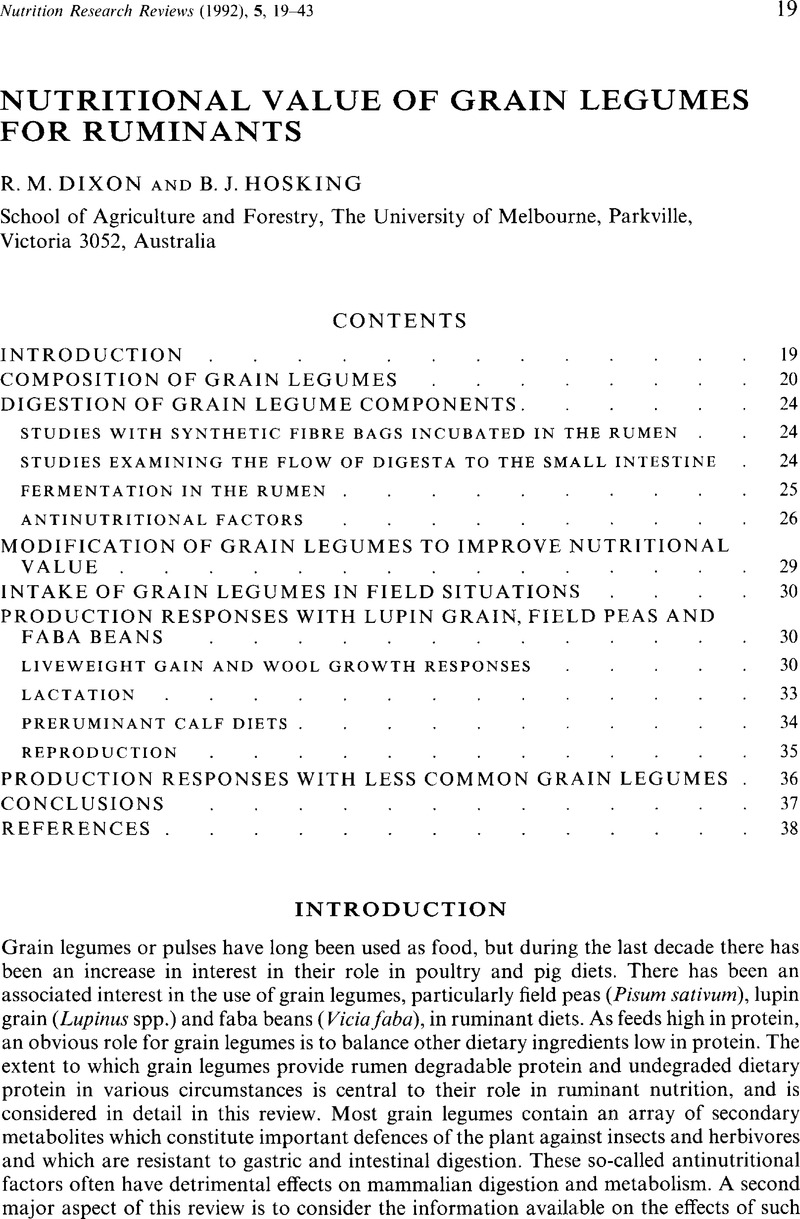Crossref Citations
This article has been cited by the following publications. This list is generated based on data provided by Crossref.
Jaques, S.
Dixon, R.M.
and
Holmes, J.H.G.
1994.
Narbon beans and field peas as supplements for sheep.
Small Ruminant Research,
Vol. 15,
Issue. 1,
p.
39.
Paduano, D.C.
Dixon, R.M.
Domingo, J.A.
and
Holmes, J.H.G.
1995.
Lupin (Lupinus angustifolius), cowpea (Vigna unguiculata) and navy bean (Phaseolus vulgaris) seeds as supplements for sheep fed low quality roughage.
Animal Feed Science and Technology,
Vol. 53,
Issue. 1,
p.
55.
Masters, D. G.
Stewart, C. A.
Mata, G.
and
Adams, N. R.
1996.
Responses in wool and live weight when different sources of dietary protein are given to pregnant and lactating ewes.
Animal Science,
Vol. 62,
Issue. 3,
p.
497.
Goelema, J.O.
Spreeuwenberg, M.A.M.
Hof, G.
van der Poel, A.F.B.
and
Tamminga, S.
1998.
Effect of pressure toasting on the rumen degradability and intestinal digestibility of whole and broken peas, lupins and faba beans and a mixture of these feedstuffs.
Animal Feed Science and Technology,
Vol. 76,
Issue. 1-2,
p.
35.
van Barneveld, Robert J.
1999.
Understanding the nutritional chemistry of lupin (Lupinus spp.) seed to improve livestock production efficiency.
Nutrition Research Reviews,
Vol. 12,
Issue. 2,
p.
203.
van Barneveld, R. J.
Edwards, A. C.
and
Huisman, J.
2000.
Linking Research and Marketing Opportunities for Pulses in the 21st Century.
Vol. 34,
Issue. ,
p.
661.
Petterson, D. S.
Coffey, R. S.
Sweetingham, M. A.
and
Allen, J. G.
2000.
Linking Research and Marketing Opportunities for Pulses in the 21st Century.
Vol. 34,
Issue. ,
p.
575.
Hadjipanayiotou, M
2002.
Replacement of soybean meal and barley grain by chickpeas in lamb and kid fattening diets.
Animal Feed Science and Technology,
Vol. 96,
Issue. 1-2,
p.
103.
White, C.L
Hanbury, C.D
Young, P
Phillips, N
Wiese, S.C
Milton, J.B
Davidson, R.H
Siddique, K.H.M
and
Harris, D
2002.
The nutritional value of Lathyrus cicera and Lupinus angustifolius grain for sheep.
Animal Feed Science and Technology,
Vol. 99,
Issue. 1-4,
p.
45.
Hoffmann, Ellen M
Muetzel, Stephan
and
Becker, Klaus
2003.
The fermentation of soybean meal by rumen microbes in vitro reveals different kinetic features for the inactivation and the degradation of trypsin inhibitor protein.
Animal Feed Science and Technology,
Vol. 106,
Issue. 1-4,
p.
189.
Banchero, G. E.
Quintans, G.
Martin, G. B.
Milton, J. T. B.
and
Lindsay, D. R.
2004.
Nutrition and colostrum production in sheep. 2. Metabolic and hormonal responses to different energy sources in the final stages of pregnancy.
Reproduction, Fertility and Development,
Vol. 16,
Issue. 6,
p.
645.
Peiretti, P.G.
Palmegiano, G.B.
and
Masoero, G.
2004.
Chemical composition, organic matter digestibility and fatty acid content of evening primrose (Oenothera paradoxa) during its growth cycle.
Animal Feed Science and Technology,
Vol. 116,
Issue. 3-4,
p.
293.
Singh, Sultan
Kundu, S.S.
Negi, A.S.
and
Singh, P.N.
2006.
Cowpea (Vigna unguiculata) legume grains as protein source in the ration of growing sheep.
Small Ruminant Research,
Vol. 64,
Issue. 3,
p.
247.
Bowen, M. K.
Pepper, P. M.
Winkleman, J. L.
McPhie, R. C.
and
Winter, M. R.
2008.
Using automated supplementation systems to meet growth targets for grazing sheep.
Australian Journal of Experimental Agriculture,
Vol. 48,
Issue. 9,
p.
1201.
Boguhn, J.
Kluth, H.
Bulang, M.
Engelhard, T.
Spilke, J.
and
Rodehutscord, M.
2008.
Effects of using thermally treated lupins instead of soybean meal and rapeseed meal in total mixed rations on in vitro microbial yield and performance of dairy cows.
Journal of Animal Physiology and Animal Nutrition,
Vol. 92,
Issue. 6,
p.
694.
Bowen, M. K.
Pepper, P. M.
McPhie, R. C.
and
Winter, M. R.
2009.
Evaluation of a remote drafting system for regulating sheep access to supplement.
Animal Production Science,
Vol. 49,
Issue. 3,
p.
248.
Ferruzzi, Guido
Pistoia, Alessandro
Balestri, Gino
Casarosa, Laura
and
Poli, Piera
2009.
Effect of different processing methods on the nutritional characteristics and tannin content of fababean seed (Vicia faba minor).
Italian Journal of Animal Science,
Vol. 8,
Issue. sup2,
p.
298.
Corriher, V.A.
Hill, G.M.
Bernard, J.K.
Jenkins, T.C.
West, J.W.
and
Mullinix, B.G.
2010.
Pigeon peas as a supplement for lactating dairy cows fed corn silage-based diets.
Journal of Dairy Science,
Vol. 93,
Issue. 11,
p.
5309.
Budag, Cemal
and
Bolat, Duran
2010.
Effect of Different Protein Sources on Microbial Protein Synthesis in Sheep Feed Maize Based Diets.
Journal of Animal and Veterinary Advances,
Vol. 9,
Issue. 3,
p.
623.
Makkar, Harinder PS
and
Becker, Klaus
2010.
Are Jatropha curcas phorbol esters degraded by rumen microbes?.
Journal of the Science of Food and Agriculture,
Vol. 90,
Issue. 9,
p.
1562.



